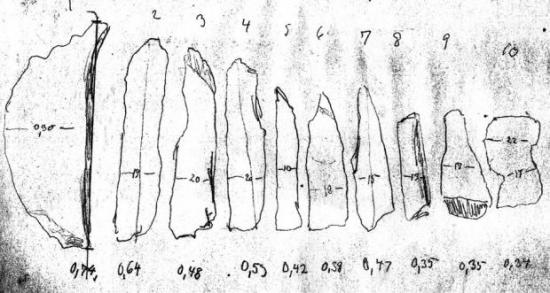PART.2
Why white?

Urd, Verdande and Skuld, also called Norns in Norse mythology, are the three goddesses of destiny. They sit in Åsgård at the roots of the world tree Yggdrasil. One of their tasks is to pour white sand over the tree roots. (Illustration: Die Helden und Götter des Nordens, oder Das Buch der Sagen. G. Gropius)
Archaeologist Th. Petersen was the first to describe these as “sacred white stones”, alluding to the light marble they were usually made of.
The white colour has had special significance, also in Scandinavian mythology, where white is perceived as representing the transcendent. The Poetic Edda poem Gudrunkvadet refers to “taking the oath by the white sacred stone”. The white phallic stones are reminiscent of a holy altar, where it would have been natural to swear the oath.
It does not seem to be coincidental that most stone phalluses are white. Linguistically, the word white has arisen from Greek leukos,’light’. The white colour symbolizes ritual purity and wisdom – but also death.
In many cultures, white is the colour of priestly attire. Celtic druids were dressed in white, Egyptian pharaohs had white crowns, and Persians believed all gods were dressed in white. These examples all tie the colour to the divine.
The Poetic Edda poem Völuspá mentions white sand that is scooped up from Urd’s well and poured over the tree Yggdrasil, and in the Prose Edda story The Tricking of Gylfi, author Snorri Sturluson says that the sand that the Norns pour over the tree every day is so sacred that everything that reaches the bottom is as white as the membrane within an eggshell.
This portrayal of white sand, or water, that is poured over the tree points to fruitful and life-giving powers that sustain the cosmic principle.
In this way, phallus stones may have helped to create a cosmic connection. They served as a protection for the deceased and for the gravesite, but also strengthened the bond between the living and the dead, who still had their place in the family.
Deities
Many researchers have linked the sacred white stones to mythological analogies and tried to see them in the context of a fertility deity. Frey, Freya and Njord are the foremost of these in Norse mythology.
The historian Tacitus from 100 CE writes about the female deity Nerthus. Scientists later linked her to the Vanir god Njord, because etymologically Nerthus may have evolved to Njord, who might have been an androgynous deity.

The find from Høgberget.
Germanic tribes thought that Nerthus lived on an island in a sacred grove. In this grove there was a consecrated carriage covered by a blanket.
The priest was the only one who was allowed to touch the carriage. He knew when the goddess was present and followed her with great reverence when cows would pull her carriage. The places she honoured with a visit were celebrated with festive feasting. At these times nobody went to war or bore arms.
Maybe sacred stones were located where the deity’s procession stopped and performed rituals, with the stone as the focal point. Many stone phalluses have been found in graves, and that is probably why some have interpreted female graves with stone phalluses as goddesses’ tombs. Women were the leaders of a female-based fertility cult.
A special discovery
A very special Norwegian find from Høgberget in Skatval, Nord-Trøndelag county suggests that this may be a cult shrine, including traces of the rituals associated with a phallic cult. Here, on top of a crag, a stone phallus in a water-filled pit was discovered.
The pit was regularly shaped, filled with water, and over one meter deep. Next to the stone phallus lay several oblong marble tiles with a maximum length of 0.74 centimetres. The tiles may have been taken from a marble passage on the north side of Høgberget, approximately 150 metres from the water-filled pit.
Archaeologist Sverre Marstrander saw the pit as Mother Earth’s vulva and the white marble stones as semen entering the vulva—all as part of a magical fertility ceremony that would bring a good year and peace.
Life cycles
The phallus was a symbol of fertility, but it could also be included in a death cult. Sexuality and rebirth can be seen as a continuous cycle linked to the fertility that the stones seem to reveal. The phallus was a prestigious symbol.
Some consider the phallus to be a symbol of the god Heimdall, who in Norse mythology is one of those who will take the lead in the new world that occurs after the old one goes under in the apocalyptic Ragnarøk event.